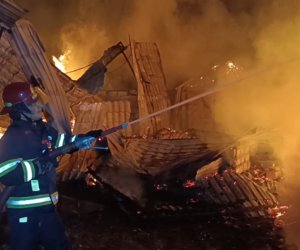What does a bomb disposal robot actually do?

For the last 40 years, crude robots have been used to defuse bombs. We look at the development of these slow, deliberate droids that face an abrupt, explosive end.
Robots go where humans fear to tread. Of their many applications, bomb disposal is one of the most hazardous, where the risk of death lurks with every move.
Bomb disposal robots have been used to safely disable explosive ordnance for over 40 years, where they have been deployed hundreds, if not thousands, of times. However, the term "bomb disposal robot” is something of a misnomer, as they are not technically robots.
According to the Oxford English Dictionary, a robot is "a machine capable of carrying out a complex series of actions automatically”. Bomb disposal robots cannot perform contextual decision-making or operate by themselves. Instead, bomb disposal robots are more accurately defined as drones, much like unmanned vehicles, as they are remotely controlled by a human operator from afar.
These robots operate as a remote presence for the bomb disposal experts, or "bomb doctors” as they are known within the British Army. This allows them to closely examine devices, without putting themselves or others in danger. Once the device has been examined, the robot can (hopefully) then render the bomb inert.
It is not just bombs that the robots disable, but also any type of device that could detonate. This can include anything from landmines to unexploded munitions.
One of the first bomb disposal robots created was the Wheelbarrow Mark 1. In 1972, Lieutenant-Colonel Peter Miller of the British Army came up with the idea of using the chassis of an electrically-powered wheelbarrow to tow suspect devices, such as car bombs, so they could be safely detonated without harming anyone.
However, the prototype Wheelbarrow proved difficult to manoeuver, so the Military Vehicles and Engineering Establishment in Chertsey were brought in to improve the control and tracking systems.
Later, Miller added Major Robert Patterson’s "pigstick” – the army’s term for a strong waterjet – to the Wheelbarrow. This allowed the Wheelbarrow to disable bombs, rather than simply tow them away.
The key to modern bomb disposal operations is to the render the explosive ordnance device inert without causing it to detonate. Bomb disposal robots typically achieve this by firing a high-pressure jet of water at wires on the device. An explosive device usually requires a power supply to detonate: disrupting this wire means the circuit is broken and thus rendered inert, if not safe. However, some devices have secondary systems that can cause the device to explode if it is tampered with. This is why bomb disposal is best carried out by a robot.
"When they drive the robot, they are looking for where they can fire the jet of water,” says an army spokesperson. "If they fire into a wire and the wire comes off, it is rendered safe, or at least for someone to go forward and declare it safe. This is why you do not get enormous explosions when they do this.”
Bomb disposal robots are controlled by operators from a safe distance. They are able to see what the robot sees, through a series of cameras on the robot’s outer casing, with the view transmitted to the operators’ monitors. Usually, there is a camera mounted on the front of the robot, so the operator is able to see where the robot is going, along with a second camera mounted on the actuator arm to provide a wider view of the surrounding area.
The original bomb disposal robots were controlled by a series of ropes. But, as technology advanced, a telecommunications cable was used to transmit commands to the robot’s electrical systems. However, cables gave the bomb disposal robot a restricted operational radius. There was also the risk of the cable becoming caught or tangled on objects – much like you might encounter with a garden hose or a vacuum cleaner.
These days the majority of bomb disposal robots are controlled through wireless communications. Whilst this does dramatically increase their operational range, there is also the possibility of hacking, although this is remote due to the layers of military security involved.
"Typically, you do not have line-of-sight and usually [the bomb disposal robots] are also thrown by hand, so you do not want an umbilical trailing from that,” says Professor Sethu Vijayakumar, director of the Edinburgh Centre of Robotics. "In this case, they are very similar to drones, with a range of a couple of kilometres.”
The design of bomb disposal robots has changed remarkably little since they were first created, as the core idea remains the same. Whilst the technology has become smaller and more robust, bomb disposal robots are still tracked, human-controlled robots, with an ‘arm’ that can manipulate suspect devices.
In terms of their mobility, bomb disposal robots have gone from having a single pair of tank-like caterpillar tracks, to variants with two pairs of caterpillar tracks and others that have six or more wheels. This allows bomb disposal robots to traverse ever more difficult terrain. Some designs can even climb stairs.
The arm of bomb disposal robots allows great versatility. Most bomb disposal teams now carry different tools which can be attached to it. This allows the robot to bypass various obstacles that would otherwise impede its progress, such as using wire-cutters to cut wire fences.
Given that bomb disposal robots are intended to operate in a variety of hostile conditions, they are able to withstand a significant amount of punishment. "Most of the cost goes into making the electronics and the sensors robust in really brutal conditions,” says Vijayakumar. "Not as much as in space, but it’s close to that.”Bomb disposal robots vary in size, from the stripped-down backpack sized robots that can be carried on a soldier’s back and thrown into buildings, to the size of a ride-on lawnmower, armed with x-ray devices and explosives detectors.
Initially, the controls for these robots were complicated, requiring specific training; now games console controllers are being used to operate them. "The prerequisite, in such high-pressure environments, is to make the controls as intuitive and as simple as possible,” says Vijayakumar. "You can put [in] very sophisticated functionality, but it needs to be operated by a typical layman and not a roboticist. It would literally be like a joystick or game controller.”
Bomb disposal robots vary in size, from the stripped-down backpack sized robots that can be carried on a soldier’s back and thrown into buildings, to the size of a ride-on lawnmower, armed with x-ray devices and explosives detectors.
Initially, the controls for these robots were complicated, requiring specific training; now games console controllers are being used to operate them. "The prerequisite, in such high-pressure environments, is to make the controls as intuitive and as simple as possible,” says Vijayakumar. "You can put [in] very sophisticated functionality, but it needs to be operated by a typical layman and not a roboticist. It would literally be like a joystick or game controller.”
The advancement in robotics and remote control systems has meant that bomb disposal robots will become increasingly adaptable to their environments in the future. There are prototypes being developed that are able to jump over walls and land on the other side. Others are being developed that have two arms, providing bomb disposal robots with greater manual dexterity, such as allowing them to open car boots and look inside.
Rather than using a single robot, function-specific robots are also being developed. These will operate together in teams, where one robot is tasked with sniffing out explosives and another with their disposal.
As the technology behind bomb disposal robots improves, so too has the number of lives they have saved. "One of the target areas, in terms of [the] use of robots, is for going into dangerous situations,” concludes Vijayakumar. "Robots can go in, be operated from a safe distance, and, in a worst-case scenario, be sacrificed.”
(BBC)
www.ann.az
Similar news
Similar news
Latest news 
More news 



































 Photo
Photo 



 Video
Video 

